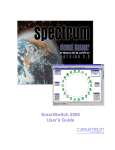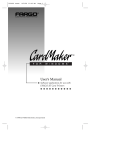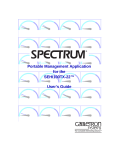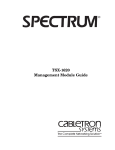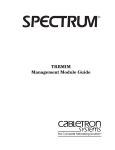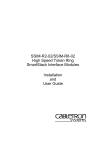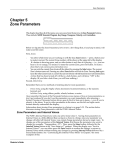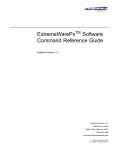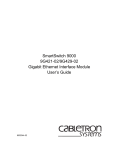Download Enterasys SSIM-H2-02 User`s guide
Transcript
STS16-20 User's Guide Notice Enterasys Networks reserves the right to make changes in speciÞcations and other information contained in this document without prior notice. The reader should in all cases consult Enterasys Networks to determine whether any such changes have been made. The hardware, Þrmware, or software described in this manual is subject to change without notice. IN NO EVENT SHALL ENTERASYS NETWORKS BE LIABLE FOR ANY INCIDENTAL, INDIRECT, SPECIAL, OR CONSEQUENTIAL DAMAGES WHATSOEVER (INCLUDING BUT NOT LIMITED TO LOST PROFITS) ARISING OUT OF OR RELATED TO THIS MANUAL OR THE INFORMATION CONTAINED IN IT, EVEN IF ENTERASYS NETWORKS HAS BEEN ADVISED OF, KNOWN, OR SHOULD HAVE KNOWN, THE POSSIBILITY OF SUCH DAMAGES. Virus Disclaimer Enterasys has tested its software with current virus checking technologies. However, because no antivirus system is 100% reliable, we strongly caution you to write protect and then verify that the Licensed Software, prior to installing it, is virus-free with an anti-virus system in which you have conÞdence. Enterasys Networks makes no representations or warranties to the effect that the Licensed Software is virus-free. Copyright © 2000 by Enterasys Networks. All rights reserved. Printed in the United States of America. Order Number: 9033047-02 April 2000 Enterasys Networks, Inc. P.O. Box 5005 Rochester, NH 03866-5005 Enterasys, NetSight, and Matrix E7 are trademarks of Enterasys Networks. SPECTRUM, MiniMMAC, FNB, Multi Media Access Center, and DNI are registered trademarks, and Portable Management Application, IRM, IRM2, IRM3, IRBM, ESXMIM, ETSMIM, EMME, EMM-E6, ETWMIM, FDMMIM, FDCMIM, MicroMMAC, MRXI, MRXI-24, NB20E, NB25E, NB30, NB35E, NBR, SEHI, STHI, TRBMIM, TRMM, TRMM-2, TRMM-4, TRMMIM, TRXI, Media Interface Module, MIM, and Flexible Network Bus are trademarks of Enterasys Networks, Inc. UNIX and OPENLOOK are trademarks of Unix System Laboratories, Inc. OSF/Motif and Motif are trademarks of the Open Software Foundation, Inc. X Window System is a trademark of X Consortium, Inc. Ethernet and XNS are trademarks of Xerox Corporation. Apple and AppleTalk are registered trademarks of Apple Computer, Inc. Banyan is a registered trademark of Banyan Systems, Inc. DECnet is a registered trademark of Digital Equipment Corporation. Novell is a registered trademark of Novell, Inc. CompuServe is a registered trademark of CompuServe. Sun Microsystems is a registered trademark, and Sun, SunNet, and OpenWindows are trademarks of Sun Microsystems, Inc. i Restricted Rights Notice (Applicable to licenses to the United States Government only.) 1. Use, duplication, or disclosure by the Government is subject to restrictions as set forth in subparagraph (c) (1) (ii) of the Rights in Technical Data and Computer Software clause at DFARS 252.227-7013. Enterasys Networks, Inc., 35 Industrial Way, Rochester, New Hampshire 03867-0505. 2. (a) This computer software is submitted with restricted rights. It may not be used, reproduced, or disclosed by the Government except as provided in paragraph (b) of this Notice or as otherwise expressly stated in the contract. (b) This computer software may be: (1) Used or copied for use in or with the computer or computers for which it was acquired, including use at any Government installation to which such computer or computers may be transferred; (2) Used or copied for use in a backup computer if any computer for which it was acquired is inoperative; (3) Reproduced for safekeeping (archives) or backup purposes; (4) Modified, adapted, or combined with other computer software, provided that the modified, combined, or adapted portions of the derivative software incorporating restricted computer software are made subject to the same restricted rights; (5) Disclosed to and reproduced for use by support service contractors in accordance with subparagraphs (b) (1) through (4) of this clause, provided the Government makes such disclosure or reproduction subject to these restricted rights; and (6) Used or copied for use in or transferred to a replacement computer. (c) Notwithstanding the foregoing, if this computer software is published copyrighted computer software, it is licensed to the Government, without disclosure prohibitions, with the minimum rights set forth in paragraph (b) of this clause. (d) Any other rights or limitations regarding the use, duplication, or disclosure of this computer software are to be expressly stated in, or incorporated in, the contract. (e) This Notice shall be marked on any reproduction of this computer software, in whole or in part. ii Contents Chapter 1 Introduction Using the STS16-20 UserÕs Guide ............................................................................... 1-2 Related Manuals............................................................................................................ 1-3 Conventions ................................................................................................................... 1-3 Common Window Fields...................................................................................... 1-4 Using Window Buttons......................................................................................... 1-5 Using the Mouse .................................................................................................... 1-5 Getting Help .................................................................................................................. 1-6 Using On-Line Help .............................................................................................. 1-6 Accessing On-line Documentation...................................................................... 1-7 Getting Help from the Global Technical Assistance Center ............................ 1-7 Chapter 2 Using the STS16-20 Chassis View Viewing Chassis Information ...................................................................................... 2-2 Viewing Front Panel Information........................................................................ 2-2 Menu Structure....................................................................................................... 2-4 Selecting a Port Status Display ............................................................................ 2-6 Port Status Display Color Codes .................................................................. 2-8 Displaying MIBs and MIB Components............................................................. 2-9 Viewing Hardware Descriptions ......................................................................... 2-9 Viewing the Device Type ............................................................................... 2-9 Viewing the Interface Description.............................................................. 2-10 Viewing System Group Information ................................................................. 2-10 Viewing I/F Summary Information.................................................................. 2-12 Displaying Interface Performance Statistics and Bar Graphs ................ 2-13 Viewing Interface Detail Statistics.............................................................. 2-15 Making Sense of Detail Statistics......................................................... 2-17 Chapter 3 Configuring ATM Connections ConÞguring Permanent Virtual Circuits ............................................................ 3-3 Adding a Permanent Virtual Circuit............................................................ 3-4 Deleting a Permanent Virtual Circuit .......................................................... 3-4 Index iii Contents iv Chapter 1 Introduction How to use the STS16-20 User’s Guide; related manuals; software conventions; getting help Welcome to NetSight Element Manager STS16-20 UserÕs Guide. We have designed this guide to serve as a reference for using NetSight Element Manager to monitor and manage the family of SmartSTACK Token Ring STS16-20 switches. The STS16-20 is a high performance, intelligent 20-port Token Ring switch that provides switching intelligence to network backbones, workgroups, and desktop connections. The STS16-20 complies to IEEE 802.5 and supports 802.1D bridging. The STS16-20 provides half or full duplex connections, auto-conÞguration, enhanced bridging capabilities, port-based VLANs, and four groups of RMON. The STS16-20 devices include the STS16-20D, STS16-20R, STS16-20RM, and STS16-20FRM. These devices are functionally identical, except for the conÞguration of ports. NOTE ¥ The STS16-20D has 20 built-in RJ-45 ports Ñ16 workstation ports and 4 network ports. ¥ The STS16-20R has 20 built-in RJ-45 ports; a RI/RO-like connection is available on all ports. ¥ The STS16-20RM has 20 built-in RJ-45 ports and supports two slots for optional SmartSTACK Interface Modules (SSIMs). A RI/RO-like connection is available on ports 19 and 20 and when a Þber expansion module is installed. ¥ The STS16-20FRM has 20 built-in Þber VF-45 ports and supports two slots for optional SmartSTACK Interface Modules (SSIMs). A RI/RO-like connection is available on all ports. For the STS16-20D, ports 1 through 16 are workstation ports, which support a single MAC address per port; ports 17 through 20 are network ports, which provide full network connectivity without a limitation on the number of MAC addresses that can be learned per port. Refer to your hardware documentation for more information. 1-1 Introduction The STS16-20RM and STS16-20FRM provide two slots for optional expansion SmartSTACK Interface Modules (SSIMs). Several types of SSIMs are available which provide either standard 4/16 Mbps Token Ring connectivity, or high speed connectivity via 155 Mbps ATM, 100 Mbps High-Speed Token Ring, and 100 Mbps Fast Ethernet, as described below: NOTE ¥ The Token Ring SSIMs (T5-04 and T8-04) provide 4 additional 4/16 Mbps ports of Token Ring connectivity via twisted-pair with RJ-45-type connectors or multimode Þber with ST-type connectors. ¥ The ATM SSIMs (A2-01 and A8-01) provide 1 port of 155 Mbps high-speed connectivity to an ATM backbone via twisted pair with RJ-45-type connectors or multimode Þber with duplex SC-type connectors. ¥ The HSTR SSIMs (R2-02 and R8-02) provide 2 ports of 100 Mbps High-Speed Token Ring connectivity via twisted pair with RJ-45-type connectors or multimode Þber and VF-45-type connectors. The HSTR SSIMs integrate Token Ring networks with High-Speed Token Ring servers or backbones. ¥ The Fast Ethernet SSIM (H2-02) is a translational switch that provides 2 ports of 10/100 Mbps Fast Ethernet connectivity via twisted pair with RJ-45-type connectors. The Fast Ethernet SSIM integrates Token Ring and Ethernet networks. Depending on the type of SSIMs installed in the STS16-20FRM and STS16-20RM, the management options available will vary. If you have an ATM SSIM (A2-01 and A8-01) installed, the ATM Connections option will be available from the Device menu. Using the STS16-20 User’s Guide Each chapter in this guide describes one major functionality or a collection of several smaller functionalities of the STS16-20, which are accessed directly from the device icon. Additional management information about tools and features common to many devices can also be found in the NetSight Element Manager UserÕs Guide, the NetSight Element Manager Tools Guide, and the Remote Administration Tools UserÕs Guide. Because the SmartSTACK Token Ring switches ÑSTS16-20RM, STS16-20FRM, STS16-20D, and STS16-20RÑ share much of their functionality, the devices will be jointly referred to as the STS16-20 throughout this guide. The options available and the information displayed in some of the windows may differ slightly, depending on the type of STS16-20 device being managed. The following is a description of the chapters contained in this guide. While we provide as much background information as we can, we do assume that you are familiar with Token Ring networks and general network management concepts. 1-2 Using the STS16-20 User’s Guide Introduction ¥ Chapter 1, Introduction, provides a list of related documentation, describes certain software conventions, and shows you how to contact Global Technical Assistance Center. ¥ Chapter 2, Using the STS16-20 Chassis View, describes the visual display of the Chassis View and explains how to use the mouse to access management applications. Also described in this chapter are device and port level monitoring functions. ¥ Chapter 3, ConÞguring ATM Connections, describes how to conÞgure Permanent Virtual Circuits (PVCs). The ATM Connections option will only be available if you have an ATM SSIM installed in your device. In addition to providing its own management capabilities, NetSight Element Manager enables you to access the SmartStack Manager for Windows 95/NT. The SmartStack Manager is a conÞguration and device management application that provides network managers with device conÞguration, performance monitoring, and troubleshooting capabilities. For more information about the SmartStack Manager, see the SmartStack Manager - Installation and UserÕs Guide. Related Manuals The STS16-20 UserÕs Guide is only part of a complete document set designed to provide comprehensive information about the features available to you through NetSight Element Manager. Use the following documents to supplement the procedures and other technical information provided in this manual: NetSight Element Manager UserÕs Guide NetSight Element Manager Tools Guide NetSight Element Manager Remote Administration Tools UserÕs Guide NetSight Element Manager Remote Monitoring (RMON) UserÕs Guide NetSight Element Manager Alarm and Event Handling UserÕs Guide Network Troubleshooting Guide For more information about the capabilities of the STS16-20, consult the appropriate hardware documentation. For more information on the features of the SmartSTACK Manager, refer to SmartSTACK Manager - Installation and UserÕs Guide. Conventions NetSight Element ManagerÕs device user interface contains a number of elements which are common to most windows and which operate the same regardless of the window in which they appear. A brief description of some of the most common elements appears below. Related Manuals 1-3 Introduction Common Window Fields Similar descriptive information is displayed in the Þelds at the top of most device-speciÞc windows in NetSight Element Manager, as shown in Figure 1-1. Device Name Location MAC Address IP Address Figure 1-1. Common Window Fields Device Name Displays the user-deÞned name of the device. The device name is entered and can be changed via the System Group window; see Viewing System Group Information in Chapter 2, or the Generic SNMP UserÕs Guide for details. IP Address Displays the deviceÕs IP (Internet Protocol) address. This is the IP address used to deÞne the device icon. IP addresses are assigned via Local Management; they cannot be changed via NetSight Element Manager. Location Displays the user-deÞned location of the device. The location is entered and can be changed via the System Group window; see Viewing System Group Information, in Chapter 2, or the Generic SNMP UserÕs Guide for details. MAC Address Displays the manufacturer-set MAC address that is associated with the IP address used to deÞne the device icon when it is added to NetSight Element Manager. This address is factory-set and cannot be altered. 1-4 Conventions Introduction Uptime Displays the amount of time that the STS16-20 has been running since the last start-up, displayed in an X day(s) hh:mm:ss format. Using Window Buttons The Cancel button that appears at the bottom of most windows allows you to exit a window and terminate any unsaved changes you have made. You may also have to use this button to close a window after you have made any necessary changes and set them by clicking on the OK, Set, or Apply button. An OK, Set, or Apply button appears in windows that have conÞgurable values; it allows you to conÞrm and set changes you have made to those values. In some windows, you may have to use this button to conÞrm each individual set; in other windows, you can set several values at once and conÞrm the sets with one click on the button. The Help button brings up a Help text box with information speciÞc to the current window; see Getting Help, page 1-6, for details. The command buttons, for example Bridge, display a menu listing the windows available for that selection. Any menu topic followed by ... (three dots) Ñ for example Statistics... Ñ launches a window associated with that selection. Using the Mouse This document assumes that you are using a Windows-compatible mouse with two buttons; if you are using a three button mouse, you should ignore the operation of the middle button when following procedures in this document. Procedures within NetSight Element Manager document set refer to these buttons as follows. Left Mouse Button Right Mouse Button Figure 1-2. Mouse Buttons Conventions 1-5 Introduction For many mouse operations, this document assumes that the left (primary) mouse button is to be used, and references to activating a menu or button will not include instructions about which mouse button to use. However, in instances in which right (secondary) mouse button functionality is available, instructions will explicitly refer to right mouse button usage. Also, in situations where you may be switching between mouse buttons in the same area or window, instructions will also explicitly refer to both left and right mouse buttons. Instructions to perform a mouse operation include the following terms: ¥ Pointing means to position the mouse cursor over an area without pressing either mouse button. ¥ Clicking means to position the mouse pointer over the indicated target, then press and release the appropriate mouse button. This is most commonly used to select or activate objects, such as menus or buttons. ¥ Double-clicking means to position the mouse pointer over the indicated target, then press and release the mouse button two times in rapid succession. This is commonly used to activate an objectÕs default operation, such as opening a window from an icon. Note that there is a distinction made between Òclick twiceÓ and Òdouble-click,Ó since Òclick twiceÓ implies a slower motion. ¥ Pressing means to position the mouse pointer over the indicated target, then press and hold the mouse button until the described action is completed. It is often a pre-cursor to Drag operations. ¥ Dragging means to move the mouse pointer across the screen while holding the mouse button down. It is often used for drag-and-drop operations to copy information from one window of the screen into another, and to highlight editable text. Getting Help This section describes different methods of getting help for questions or concerns you may have while using NetSight Element Manager. Using On-Line Help You can use the Help button in the STS16-20 windows to obtain information speciÞc to the device. When you click on a Help button, a window will appear which contains context-sensitive on-screen documentation that will assist you in the use of the window and its associated command and menu options. Note that if the Help button is grayed out, on-line help has not yet been implemented for the associated window. 1-6 Getting Help Introduction From the Help menu accessed from the Chassis View window menu bar, you can launch on-line help speciÞc to the Chassis View window, as well as bring up the Chassis Manager window for reference. NOTE All of the on-line help windows use the standard Microsoft Windows help facility. If you are unfamiliar with this feature of Windows, you can select Help from the Windows Start menu, or Help Ñ> How to Use Help from the primary NetSight Element Manager window, or consult your Microsoft Windows product UserÕs Guide. Accessing On-line Documentation The complete suite of documents available for NetSight Element Manager can be accessed via a menu option from the primary window menu bar: Help Ñ> Online Documents. If you chose to install the documentation when you installed NetSight Element Manager, selecting this option will launch AdobeÕs Acrobat Reader and a menu Þle which provides links to all other available documents. TIP If you have not yet installed the documentation, the Online Documents option will not be able to access the menu Þle. In order to activate this option, you must run the setup.exe again to install the documentation component. See your Installation Guide for details. Getting Help from the Global Technical Assistance Center If you need technical support related to NetSight Element Manager, contact the Global Technical Assistance Center via one of the following methods: By phone: (603) 332-9400 24 hours a day, 365 days a year By fax: (603) 337-3075 By mail: Enterasys Networks Technical Support 35 Industrial Way Rochester, NH 03867 By e-mail: [email protected] FTP: ftp.ctron.com (134.141.197.25) Login Password By BBS: Modem Setting Getting Help anonymous your email address (603) 335-3358 8N1: 8 data bits, 1 stop bit, No parity 1-7 Introduction Send your questions, comments, and suggestions regarding NetSight documentation to NetSight Technical Communications via the following e-mail address: [email protected] To locate product speciÞc information, refer to the Enterasys Web site at the following address: http://www.enterasys.com NOTE 1-8 For the highest Þrmware versions successfully tested with NetSight Element Manager 2.2.1, refer to the Readme Þle available from the NetSight Element Manager program group. If you have an earlier version of Þrmware and experience problems, contact the Global Technical Assistance Center. Getting Help Chapter 2 Using the STS16-20 Chassis View Navigating through the Chassis View; viewing Chassis information; using source address functions The STS16-20 Chassis View window is the main screen that immediately informs you of the current condition of individual ports on your switch via a color-coded graphical display. The Chassis View window serves as a single point of access to all applications and windows which are discussed in the following sections and chapters. To access the STS16-20 Chassis View window: 1. In any map, list, or tree view, double-click on the device icon of the STS16-20 you wish to manage. Figure 2-1. SmartSTACK Icon or 1. In any map, list, or tree view, click the left mouse button once to select the STS16-20 you wish to manage. 2. Select Manage—>Node from the main NetSight Element Manager window menu bar, or select the Manage Node toolbar button. or 1. In any map, list, or tree view, click the right mouse button once to select the STS16-20 you wish to manage. 2. On the resulting menu, click Manage. 2-1 Using the STS16-20 Chassis View Viewing Chassis Information The Chassis View window (Figure 2-2) provides a graphical representation of the STS16-20, including a color-coded port status display which immediately informs you of the current conÞguration and status of the device and its ports. You can access the menus that lead to more detailed device- and port- level windows by clicking in the designated areas of the graphical display, or by using the menu bar at the top of the Chassis View window. The color-coded Port Status Display lets you view the status of the device’s ports, according to the parameters selected from the Port Status menu. The Menu Bar contains Device, Port Status, Utilities, and Help menus. The Front Panel displays status information about the device. Figure 2-2. The STS16-20 Chassis View Window TIP When you move the mouse cursor over a management Òhot spotÓ the cursor icon will change into a hand symbol to indicate that clicking in the current location will bring up a management option. Viewing Front Panel Information The Front Panel section provides the following device information: Connection Status This color-coded icon indicates the current state of communication between NetSight Element Manager and the STS16-20: ¥ 2-2 Green indicates a valid connection; the STS16-20 is responding to device polls. Viewing Chassis Information Using the STS16-20 Chassis View ¥ Magenta indicates a temporary stand-by mode, while the STS16-20 responds to a physical change in the switch. ¥ Blue indicates an unknown contact status; polling has not yet been established with the STS16-20. ¥ Red indicates that the STS16-20 is not responding to device polls (the device is off line, or device polling has failed across the network). Up Time The amount of time that the STS16-20 has been running without interruption since the last start-up, displayed in an X day(s) hh:mm:ss format. Port Status Indicates the Port Status display selection currently in effect; see Selecting a Port Status Display, page 2-6, for details. The default port status display is Admin; if you have not changed the port status selection since launching the Chassis View, this Þeld will display Default. MAC The physical layer address assigned to the interface associated with the IP Address used to deÞne the device icon when it was added to NetSight Element manager. MAC addresses are hard-coded into the device, and are not conÞgurable. Boot Prom The revision of BOOT PROM installed in the STS16-20. Firmware The revision of device Þrmware installed in the switchÕs ßash memory. Time The current time set in the internal clock of the STS16-20, displayed in a 24-hour hh:mm:ss format. Date The current date set in the internal clock of the STS16-20, displayed in a mm/dd/yyyy format. NOTE For some Þrmware versions, the Time, Date, and Boot Prom Þelds will display as N/A (not available). IP Address The IP (Internet Protocol) address assigned to the device will appear in the title bar of the Chassis View. Viewing Chassis Information 2-3 Using the STS16-20 Chassis View Menu Structure By clicking on various areas of the STS16-20 Chassis View, you can access menus with device and port level options, as well as utility applications which apply to the device. Figure 2-3 displays the menu structure for the STS16-20, and indicates how to use the mouse to access the various menus. Figure 2-3. Sample Chassis View Menu Structure (STS16-20RM with an ATM SSIM) NOTE Depending on the type of SSIM(s) installed in the STS16-20FRM and STS16-20RM, the options available will vary. If you have an ATM SSIM (A2-01 and A8-01) installed, the ATM Connections option will be available from the Device menu. For this release, additional management support is not provided for the Token Ring SSIMs (T5-04 and T8-04), the HSTR SSIMs (R2-02 and R8-02), and the Fast Ethernet SSIM (H2-02). The Device Menu From the Device menu of the Chassis View menu bar, you can access the following selections: ¥ 2-4 Device Type displays a hardware description of the device; see Viewing the Device Type, page 2-9, for details. Viewing Chassis Information Using the STS16-20 Chassis View ¥ System Group allows you to manage the STS16-20 by providing direct access via SNMP to MIB II variables. Refer to the Generic SNMP UserÕs Guide for more information on SNMP, or see Viewing System Group Information, page 2-10, to edit the name, contact, and location Þelds. ¥ I/F Summary displays statistics for the trafÞc processed by each network interface on the device, including a detailed transmit and receive trafÞc breakdown; see Viewing I/F Summary Information, page 2-12, for details. ¥ ATM Connections lets you conÞgure Permanent Virtual Circuits (PVCs) on the device. The ATM Connections option will only appear if you have an ATM SSIM (A2-01 or A8-01) installed in the STS16-20RM or STS16-20FRM; see Chapter 3, ConÞguring ATM Connections, for details. ¥ Exit closes the STS16-20 Chassis View window. The Port Status Menu The Port Status menu allows you to select the status information that will be shown in the Chassis ViewÕs port status display. NOTE NOTE ¥ Status allows you to select one of two status types: Admin, or Operator. ¥ Load displays the portion of network load processed per polling interval by each interface as a percentage of the theoretical maximum load (4 or 16 Mbps). For this release, the Load port status option will display three dashes and maintain the color code of the most recently selected option for any unlinked ports (i.e. ports for which the Operator status is OFF). ¥ Errors displays the number of errors detected per polling interval by each interface as a percentage of the total number of valid packets processed by the interface. ¥ I/F Mapping displays the interface value associated with each port on the STS16-20. ¥ I/F Speed displays the speed (4 or 16 Mbps) of the network segment attached to each port. For this release, the I/F Speed port status option will display a zero and maintain the color code of the most recently selected option for any unlinked ports (i.e. ports for which the Operator status is OFF). ¥ I/F Type displays the interface type of each port: TR for Token Ring. Viewing Chassis Information 2-5 Using the STS16-20 Chassis View The Utilities Menu From the Utilities menu, you can select the following options: ¥ MIB Tools provides direct access to the deviceÕs Management Information Bases (MIBs); refer to the Tools Guide for more information. ¥ SmartStack Manager launches the Windows 95/NT SmartStack Manager, which provides device conÞguration, performance monitoring, and troubleshooting options. This selection will appear only if the SmartStack Manager is installed on your NetSight workstation; refer to the SmartStack Manager - Installation and UserÕs Guide for more information. ¥ RMON allows you to distribute network monitoring functions through your network to smart devices; refer to the Remote Monitoring (RMON) UserÕs Guide for more information. The MIB Tools and RMON selections are also available from the Tools menu at the top of the primary NetSight Element Manager window. The Help Menu The Help menu has the following three selections: ¥ MIBs Supported opens the Chassis Manager window which displays the MIBs, RFCs, and MIB Components contained on the device; see Displaying MIBs and MIB Components, page 2-9, for details. ¥ Chassis Manager Help opens a help window with information speciÞcally related to using the Chassis Manager and Chassis View windows. ¥ About Chassis Manager opens a version window for the Chassis Manager application in use. The Port Menus The Port menu offers the following selections: ¥ Description displays a hardware description of the selected port; see Viewing the Interface Description, page 2-10, for details. ¥ I/F Statistics displays transmit and receive packets for the selected port; see Viewing Interface Detail Statistics, page 2-15, for details. Selecting a Port Status Display The port status display graphically depicts all interfaces supported by the STS16-20. When you open the Chassis View, each port on the STS16-20 will display its Admin status (see page 2-7). To change the port status display, select one of the options on the Port Status menu, as described in the following section. 2-6 Viewing Chassis Information Using the STS16-20 Chassis View NOTE The Port Status options allow you to display status information for the 20 built-in Token Ring ports. The Port Status options do not display status information for any SSIMs installed in the STS16-20RM and STS16-20FRM. To change the port status display: 1. Click on Port Status in the Chassis View menu bar to access the Port Status menu. 2. Click to select the status information you want to display; the appropriate status information will be shown in the port status display. The port status options available as follows: Status Displays bridge status information for each port, as determined by the selected submenu option: ¥ ¥ NOTE Admin displays each bridge portÕs administrative status: - ON (Green) Ñ The port has been enabled by management and has a valid link. - OFF (Red) Ñ The port has not been enabled or it has been disabled through a management action. - N/A (Blue) Ñ The administrative status is not available. Operator displays each bridge portÕs actual operational state: - ON (Green) Ñ The port is currently forwarding packets. - OFF (Red) Ñ The port is not currently forwarding packets. - N/A (Blue) Ñ The operator status is not available. The Admin status provides the state requested by management; the Operator status provides the actual state of the port. Depending on the circumstances, the Operator status may or may not match the Admin status currently requested by management. For example, ports which are administratively ON but not yet connected would display an Operator status of OFF, since no packets are being forwarded. Load Displays the percentage of network load processed by each port during the last polling interval. This percentage reßects the network load generated per polling interval by devices connected to the port compared to the theoretical maximum load (4 or 16 Mbps) of the network. Viewing Chassis Information 2-7 Using the STS16-20 Chassis View NOTE For this release, the Load port status option will display three dashes and maintain the color code of the most recently selected Port Status option for any unlinked ports (i.e. ports for which the Operator status is OFF). Errors Displays the percentage of the total number of valid packets processed by each port during the last polling interval that were error packets. This percentage reßects the number of errors generated during the last polling interval by devices connected to that port compared to the total number of valid packets processed by the port. NOTE The polling interval is set via the Tools Ñ> Options window from the primary window menu bar. Refer to the NetSight Element Manager UserÕs Guide for more information on setting device polling intervals. I/F Mapping Displays the index value associated with each port on the STS16-20. I/F Speed Displays the speed (4 or 16 Mbps) of the network segment connected to each port. NOTE For this release, the I/F Speed port status option will display a zero and maintain the color code of the most recently selected Port Status option for any unlinked ports (i.e. ports for which the Operator status is OFF). I/F Type Displays the interface type of each port on the STS16-20: TR for Token Ring. Port Status Display Color Codes The port status display options incorporate color coding schemes. For the Admin, and Operator display options the color coding scheme is described above. For all other port status display selections Ñ Load, Errors, I/F Mapping, I/F Speed, and I/F Type Ñ color codes will reßect the most recently selected option which incorporates its own color coding scheme. 2-8 Viewing Chassis Information Using the STS16-20 Chassis View Displaying MIBs and MIB Components Like most networking devices, the STS16-20 draws its functionality from a collection of proprietary MIBs, and IETF RFCs. The MIB data is organized into a series of Òcomponents,Ó which is a logical grouping of MIB data with each group controlling a deÞned set of objects. There is no one-to-one correspondence between MIBs and MIB components. A single MIB component might contain objects from several different proprietary MIBs and RFCs. The Chassis Manager window (Figure 2-4) is a read-only window that displays the MIBs and the MIB components Ñ and, therefore, the functionality Ñ supported by the currently monitored device. To open the Chassis Manager window: 1. Click on Help in the Chassis View menu bar to access the Help menu. 2. Click on MIBs Supported. The Chassis Manager window, Figure 2-4, will appear. The MIBs which provide the functionality for the STS16-20 — both proprietary and IETF RFCs — are listed here. The MIB Components are listed here. Note, there is no one-to-one correspondence between MIBs and MIB Components. Figure 2-4. Chassis Manager Window Viewing Hardware Descriptions Menu options available at the device and port levels provide speciÞc information about the physical characteristics of the STS16-20 and its ports. Viewing the Device Type The Device Type window displays a hardware description of the device. To open the Device Type window: 1. Click on Device in the Chassis View menu bar to access the Device menu. 2. Click on Device Type. A Device Type window, similar to the one shown in Figure 2-5, will appear. Viewing Chassis Information 2-9 Using the STS16-20 Chassis View Figure 2-5. Sample Device Type Window Viewing the Interface Description The Interface Description window displays a text description, which includes the product name and hardware version number. To open the Interface Description window: 1. Click on the port of interest to access the Port menu. 2. Click on Description; an Interface Description window, similar to the examples shown in Figure 2-6, will appear. Figure 2-6. Sample Interface Description Windows Viewing System Group Information The System Group window allows you to view and modify the contact, name, and location for your STS16-20. The System Group window also provides direct access via SNMP to MIB II variables; refer to the Generic SNMP UserÕs Guide for more information. 2-10 Viewing Chassis Information Using the STS16-20 Chassis View To open the System Group window: 1. Click on Device in the Chassis View menu bar to access the Device menu. 2. Click on System Group. The System group window, as shown in Figure 2-7, will appear. Figure 2-7. System Group Window The System Group window contains the following Þelds: Contact Displays the user-deÞned name of the contact person responsible for the device. Name Displays the user-deÞned name of the device. Location Displays the user-deÞned location of the device. Services Displays the level of OSI service supported by the device. To add or modify System Group information: 1. Click on the I-bar button in the Contact, Name, or Location fields. A text window will appear which allows you to add or modify the entry. 2. Enter the new or modified contact, name, or location information. 3. Click OK to accept the changes or Cancel to exit without saving changes. Viewing Chassis Information 2-11 Using the STS16-20 Chassis View Viewing I/F Summary Information The I/F Summary option displays statistics for the trafÞc processed by each network interface on your device. The I/F Summary window also provides access to a detailed statistics window via the Detail button that breaks down transmit and receive trafÞc for each interface. To open the I/F Summary window: 1. Click on Device on the Chassis View menu bar to access the Device menu. 2. Click on I/F Summary. The I/F Summary window, as shown in Figure 2-8, will appear. You can select the type of statistic and the unit of measure displayed. Base Unit displays the statistical unit as Load, Raw Counts, or Rate. Measurement parameter displays the selected statistical unit. The Detail button launches the I/F Statistics window. The I/F Display section lets you view descriptive information for each interface. Figure 2-8. I/F Summary Window The I/F Display section lets you view descriptive information for each interface. The two drop-down lists (in the upper right corner) are used to display interface performance statistics and, where applicable, bar graphs. The Detail button provides additional statistics on the transmit and receive trafÞc for each interface. NOTE 2-12 The I/F Display section for the STS16-20 lists interface information for each of the 20 built-in ports, followed by any installed SSIMs, and internal interfaces. When two or more STS16-20 SmartSTACK switches are stacked together, the I/F Display section will list the interfaces for each switch in the stack as described previously. Viewing Chassis Information Using the STS16-20 Chassis View The following descriptive information is provided for each interface: Index The index value assigned to each interface on the device. Type The type of the interface, distinguished by the physical/link protocol(s) running immediately below the network layer: Token Ring for the built-ports; other values, such as ATM, will display for the installed SSIMs. Description A text description of the interface: the device type (e.g. STS-16-20RM) will display for the 20 built-in Token Ring ports; the SSIM type (e.g. SSIM-A8-01) will display for any installed SSIMs; and other values will display for any internal interfaces. Physical Status The current physical statusÑor operational stateÑof the interface: Online or Ofßine. Logical Status The current logical statusÑor administrative stateÑof the interface: Up or Down. Displaying Interface Performance Statistics and Bar Graphs The statistical values (and, where available, the accompanying bar graphs) provide a quick summary of interface performance. You can select the type of statistical value and the unit to be displayed by using the two drop-down lists directly above the I/F Display section, as follows: 1. From the right-most drop-down list of the I/F Summary window, click on the unit in which you wish to display the selected statistic: Load, Raw Counts, or Rate. 2. Once you have selected the base unit, click on the left-most drop-down list to specify the display statistic. Note that the options available from this menu will vary depending on the base unit you have selected. NOTE Bar graphs are only available when Load is the selected base unit; if you select Raw Counts or Rate, the Bar Graph column will be removed from the interface display. After you select a new display mode, the statistics (and bar graphs, where applicable) will refresh to reßect the current mode, as described below. Viewing Chassis Information 2-13 Using the STS16-20 Chassis View Raw Counts The total count of network trafÞc received or transmitted on the selected interface since device counters were last reset. Raw counts are provided for the following parameters: ¥ In Octets Ñ for octets received on the interface, including framing characters. ¥ In Packets Ñ for packets (both unicast and non-unicast) received by the device interface and delivered to a higher-layer protocol. ¥ In Discards Ñ for packets received by the device interface that were discarded even though no errors prevented them from being delivered to a higher layer protocol (e.g., to free up buffer space in the device). ¥ In Errors Ñ for packets received by the device interface containing errors that prevented them from being delivered to a higher-layer protocol. ¥ In Unknown Ñ for packets received by the device interface that were discarded because of an unknown or unsupported protocol. ¥ Out Octets Ñ for octets transmitted by the interface, including framing characters. ¥ Out Packets Ñ for packets transmitted, at the request of a higher level protocol, by the device interface to a subnetwork address (both unicast and non-unicast). ¥ Out Discards Ñ for outbound packets that were discarded by the device interface even though no errors were detected that would prevent them from being transmitted. A possible reason for discard would be to free up buffer space in the device. ¥ Out Errors Ñ for outbound packets that could not be transmitted by the device interface because they contained errors. Load The number of bytes processed by the selected interface during the last poll interval in comparison to the theoretical maximum load for the selected interface type (4 or 16 Mbps for the built-in Token Ring ports; 100 Mbps for the high-speed Token Ring and Ethernet SSIMs; and 155 Mbps for the ATM SSIMs). Load is further deÞned by the following parameters: ¥ In Octets Ñ the number of bytes received by this interface, expressed as a percentage of the theoretical maximum load. ¥ Out Octets Ñ the number of bytes transmitted by this interface, expressed as a percentage of the theoretical maximum load. When you select this option, a Bar Graph Þeld will be added to the I/F Display section; this Þeld is only available when Load is the selected base unit. 2-14 Viewing Chassis Information Using the STS16-20 Chassis View Rate The count for the selected statistic during the last poll interval. The parameters for Rate are the same as those provided for Raw Counts; for a complete description, see Raw Counts, page 2-14. Viewing Interface Detail Statistics The Interface Statistics window provides detailed trafÞc statistics for each individual interface, including counts for both transmit and receive packets, and error and buffering information. Color-coded pie charts graphically display statistics for both received and transmitted unicast, multicast, discarded, and error packets. The I/F Statistics window can be accessed from the I/F Summary window and from the individual Port menus. To open the Interface Statistics window from the I/F Summary window: 1. Click to select the interface for which you would like to view more detailed statistics. The selected interface will be highlighted blue. 2. Click on the Detail button; the I/F Statistics window, as shown in Figure 2-9, will appear. To open the Interface Statistics window from a Port menu: 1. From the Chassis View’s port status display, click to select the port of interest to access the Port menu. 2. Click on I/F Statistics; the I/F Statistics window, as shown in Figure 2-9, will appear. Figure 2-9. Interface Statistics Window Viewing Chassis Information 2-15 Using the STS16-20 Chassis View The following three informational Þelds appear in the upper portion of the window: Description The interface description for the currently selected interface. Address The MAC (physical) address of the selected interface. Type The interface type of the selected port. The lower portion of the window provides the following transmit and receive statistics. The Þrst four statistics are also displayed in pie charts. Unicast The number of packets transmitted to or received from this interface that had a single, unique destination address. These statistics are displayed in the pie chart, color-coded green. Non-Unicast The number of packets transmitted to or received from this interface that had a destination address that is recognized by more than one device on the network segment. The multicast Þeld includes a count of broadcast packetsÑthose that are recognized by all devices on a segment. These statistics are displayed in the pie chart, color-coded dark blue. Discarded The number of packets which were discarded even though they contained no errors that would prevent transmission. These statistics are displayed in the pie chart, color-coded magenta. Good packets are typically discarded to free up buffer space when the network becomes very busy. If this occurs routinely, it usually indicates that network trafÞc is overwhelming the device. To solve this problem, you may need to reconÞgure your bridging parameters, or perhaps reconÞgure your network to add additional bridges or switches. Refer to the Network Troubleshooting Guide for details. Error The number of packets received or transmitted that contained errors. These statistics are displayed in the pie chart, color-coded red. Unknown Protocol (Received Packets only) The number of packets received which were discarded because they were created under an unknown or unsupported protocol. Packets Received (Received Packets only) The number of packets received by the selected interface. 2-16 Viewing Chassis Information Using the STS16-20 Chassis View Transmit Queue Size (Transmit Packets only) The number of packets currently queued for transmission from this interface. The amount of device memory devoted to buffer space and the trafÞc level on the target network determines how large the output packet queue can expand before the module will begin to discard packets. Packets Transmitted (Transmit Packets only) The number of packets transmitted by this interface. Making Sense of Detail Statistics By using a few simple calculations, the I/F Statistics window can give you a good sense of the activity level and performance of the selected interface: To calculate the percentage of input errors: Received Errors /Packets Received To calculate the percentage of output errors: Transmitted Errors /Packets Transmitted To calculate the total number of inbound and outbound discards: Received Discards + Transmitted Discards To calculate the percentage of inbound packets that were discarded: Received Discards /Packets Received To calculate the percentage of outbound packets that were discarded: Transmit Discards /Packets Transmitted NOTE Unlike the Interface Detail window, which this window replaces, the Interface Statistics window does not offer Disable or Test options. These options are available in the Interface Group window, accessed via the System Group window (DeviceÑ>System Group). Refer to your Generic SNMP UserÕs Guide for more information on the System Group and Interface Group windows. Viewing Chassis Information 2-17 Using the STS16-20 Chassis View 2-18 Viewing Chassis Information Chapter 3 Configuring ATM Connections Viewing connection data; adding and deleting Permanent Virtual Circuits (PVCs) The ATM Connections window is available when an ATM SSIM is installed in the STS16-20RM or STS16-20FRM. An ATM SSIM allows you to integrate the STS16-20 with an ATM backbone. An ATM network uses two types of virtual channels or circuits: Switched Virtual Circuits (SVCs) and Permanent Virtual Circuits (PVCs). SVCs are created and dismantled dynamically on an as-needed basis, and require no management deÞnition. By contrast, PVCs must be individually and manually conÞgured. The ATM Connections window lets you view and modify Permanent Virtual Circuits established at the device. To access the ATM Connections window: 1. Click on Device in the Chassis View menu bar to display the Device menu. 2. Click on ATM Connections. The Current ATM Connections window, as shown in Figure 3-1, will appear. NOTE The ATM Connections option will only be available when at least one ATM SSIM (A2-01 or A8-01) is installed in the device. 3-1 Configuring ATM Connections Figure 3-1. Current ATM Connections Windows The Current ATM Connections window provides the following information about the deviceÕs ATM connections: Connection Data The Connection Data list box displays the conÞguration parameters for each ATM interface available on the device. 3-2 I/F The index number assigned to each ATM SSIM installed in the STS16-20. If an ATM SSIM is installed in the left hand slot, the value in this Þeld will be 21; if an ATM SSIM is installed in the right hand slot, the value in this Þeld will be 25. Maximum Connections The maximum number of connections allowed by the current version of Þrmware. Current ConÞgured The maximum number of connections the port will keep active at one time; the default value is 2048. Configuring ATM Connections Settings The Settings group box contains information about each of the currently conÞgured PVCs, as well as the Þelds used to conÞgure new connections. I/F The device interface index on which the PVC was conÞgured. An ATM SSIM installed in the left hand slot will have an I/F value of 21; an ATM SSIM installed in the right hand slot will have an I/F value of 25. VPI The Virtual Path IdentiÞer assigned to the connection. Allowable values are 0 - 3. VPIs are used to group virtual connections, allowing for channel trunking between ATM switches. Each VPI can be conÞgured to carry many different channels (designated by Virtual Channel IdentiÞers) between two points. VCI The Virtual Channel IdentiÞer assigned to the connection. Allowable values are 0 - 1023 for each VPI. Each assigned VCI must be unique within its deÞned VPI. However, you can assign the same VCI to multiple VPIs (e.g., VPI 0/VCI 14, VPI 1/VCI 14, VPI 2/VCI 14, etc.). Remember, it is the combined VPI and VCI designations assigned to a channel that create the grouping of virtual connections. Encapsulation The method used to encapsulate LAN packets on the selected Type circuit. Current versions of ATM SSIM Þrmware use VC MUX 802.5 LANE as the encapsulation method. Status The current administrative status of the connection: Enabled or Disabled. UpTime The length of time the selected connection has been enabled. Configuring Permanent Virtual Circuits You can use the Add, Delete, or Refresh command buttons at the bottom of the Current ATM Connections window to add or delete a Permanent Virtual Circuit (PVC), or refresh the window. ¥ Add Ñ adds a new connection or modiÞes an existing connection, using the parameters entered in the Þelds below the Settings list box. A conÞrmation window will appear for additions and modiÞcations. ¥ Delete Ñ deletes the selected connection; a conÞrmation window requires that you conÞrm the deletion. ¥ Refresh Ñ refreshes the connection information displayed in the window. 3-3 Configuring ATM Connections Adding a Permanent Virtual Circuit To conÞgure a new Permanent Virtual Circuit (PVC), enter the following information in the Þelds which appear just below the Settings list box: 1. From the I/F menu, select the interface for which you wish to configure a connection. All available ATM interfaces will be listed in this menu. The I/F menu will display 21 if an ATM SSIM is installed in the left hand slot and/or 25 if an ATM SSIM is installed in the right hand slot of the switch. 2. In the VPI text box, enter the Virtual Path Identifier you wish to assign to this connection. Allowable values are 0 to 3. The VPI you assign will be used to group virtual connections, allowing for channel trunking between ATM switches. 3. In the VCI text box, enter the Virtual Channel Identifier you wish to assign to this connection. Allowable values are 0 to 1023 for each VPI. For example, you could assign the same channel identifier as many as four times: once with a VPI of 0, once with a VPI of 1, and so on. Remember that it is the combination of VPI and VCI that will be used to direct cells through the intermediate switches between the source and destination. 4. From the Encapsulation Type menu, select the desired encapsulation type; the STS16-20 uses VC MUX 802.5 LANE as the encapsulation method. 5. Click on the Add button; the parameters for the new Permanent Virtual Circuit will be added to the Settings list box. The circuit is automatically enabled, and will remain in place until it is manually deleted. Deleting a Permanent Virtual Circuit Permanent Virtual Circuits remain in place until they are manually removed using the Current ATM Connections window. To delete an existing PVC: 1. In the Settings list box, click to select the Permanent Virtual Circuit you wish to delete. The selected PVC will be highlighted blue. 2. Click on the Delete button. A confirmation window will appear, listing the parameters assigned to the connection and asking you to verify the action. 3. Click OK to proceed with the deletion; the selected PVC will be deleted. 3-4 Index A H Admin status 2-7 Apply Button 1-5 ATM Connections Configuring 3-3 ATM SSIM 1-2, 2-4, 3-1 Help Button 1-5 Help Menu 2-6 HSTR SSIM 1-2 B Boot Prom 2-3 C Cancel Button 1-5 Channel Trunking 3-3 Connection Status 2-2 Contact 2-11 D Date 2-3 Description 2-10 Device Menu 2-4 Device Name 1-4 Discarded 2-16 I I/F Mapping 2-8 I/F Speed 2-8 I/F Summary 2-12 I/F Type 2-8 Interface Statistics 2-15 IP Address 1-4, 2-3 L Load 2-7, 2-14 Location 1-4, 2-11 Logical Status 2-13 M MAC 2-3 MAC Address 1-4 Mouse Usage 1-5 E N Encapsulation Type 3-3 Errors 2-8 Name 2-11 Non-Unicast (Multicast) 2-16 F O Fast Ethernet SSIM 1-2 Firmware 2-3 Firmware Versions 1-8 OK Button 1-5 Operator status 2-7 G Getting Help 1-6 Global Technical Assistance Center 1-7 Grouping Virtual Connections 3-3 P Packets Received 2-16 Packets Transmitted 2-17 Permanent Virtual Circuits (PVCs) 3-1 Physical Status 2-13 Port Description 2-10 Port Menus 2-6 Port Status 2-3 Index-1 Index Port Status Display Selecting 2-7 Port Status Menu 2-5 PVC 3-1 R Rate 2-15 Readme 1-8 S Set Button 1-5 SmartSTACK Manager 1-3, 2-6 SmartStack Manager 1-3 SSIM 2-4 STS16-20FRM 3-1 STS16-20RM 3-1 SVC 3-1 Switched Virtual Circuits (SVCs) 3-1 System Group 2-10 Editing 2-11 T technical support 1-7 Time 2-3 Token Ring SSIM 1-2 Transmit Queue Size 2-17 Troubleshooting Guide 2-16 Type 2-13 U Unicast 2-16 Unknown Protocol 2-16 Up Time 2-3 Uptime 1-5 Utilities Menu 2-6 V VC MUX 802.5 LANE 3-3, 3-4 VCI 3-3 Virtual Channel IdentiÞer (VCI) 3-3 Virtual Path IdentiÞer (VPI) 3-3 VPI 3-3 Index-2







































